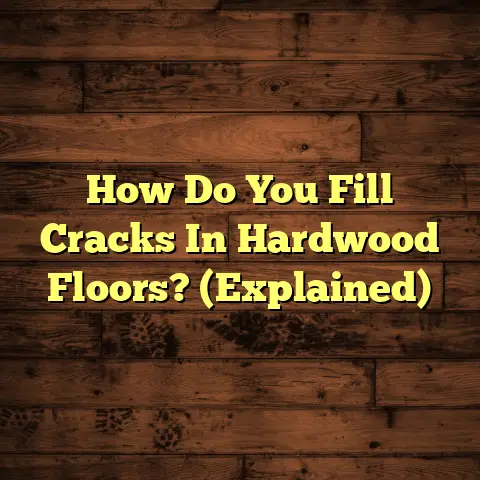Why Hardwood Floors Separate? (1 Fix Now!)
Ever noticed those annoying gaps appearing between your beautiful hardwood floorboards?
It’s a common problem, and believe me, I’ve seen it all in my years as a flooring contractor. It can be frustrating, but don’t worry, I’m here to help you understand why it happens and what you can do about it.
Before we dive deep, let me give you a quick fix you can try right now if the gaps are small: humidity control.
Often, separation is due to changes in humidity. Get a dehumidifier or humidifier (depending on your climate) and aim for a consistent humidity level. More on this later.
Now, let’s get into the nitty-gritty of hardwood floor separation!
Understanding Hardwood Floors
First, let’s talk about what makes up your hardwood floor. It’s not just any wood slapped onto a subfloor.
You’ve got different types of wood – oak, maple, hickory, walnut, and even exotic species like Brazilian cherry. Each has its own characteristics, like hardness, grain pattern, and how it reacts to moisture.
Then there are the finishes – polyurethane, oil-based, water-based, varnish – that protect the wood and give it that sheen we all love. And finally, there’s the installation method: nail-down, glue-down, or floating.
But here’s the thing: wood is a natural material. It breathes. It expands when it absorbs moisture and contracts when it dries. Think of it like a sponge. This natural expansion and contraction is a major culprit behind those pesky gaps.
There are two main types of hardwood flooring:
-
Solid Hardwood: This is what most people picture when they think of hardwood. It’s a single piece of wood, milled from a tree. Solid hardwood is more susceptible to expansion and contraction because it’s solid wood through and through.
-
Engineered Hardwood: This is made of layers of wood veneer glued together, with a top layer of real hardwood. Because of its layered construction, engineered hardwood is more stable and less prone to expansion and contraction than solid hardwood.
Which one do you have? Knowing this will help you understand why you’re seeing separation.
Common Causes of Hardwood Floor Separation
Okay, now let’s get to the heart of the matter: why exactly are your floors separating? There are several factors at play, and it’s often a combination of them.
Humidity Fluctuations
This is, in my experience, the biggest reason for hardwood floor separation. I can’t stress this enough: wood hates extreme changes in humidity.
When the air is humid, the wood absorbs moisture and expands. When the air is dry, the wood loses moisture and contracts. Over time, this constant expansion and contraction can cause gaps to form between the boards.
What’s the ideal humidity range for hardwood floors? I generally recommend shooting for 30-50%. You can use a hygrometer (a device that measures humidity) to monitor the humidity levels in your home.
Here’s a little tip: I’ve seen homes where people crank up the heat in the winter, making the air super dry. Then, in the summer, they blast the AC, which can also dry out the air. These drastic changes in humidity are a recipe for disaster for your hardwood floors.
Improper Installation
I can’t tell you how many times I’ve been called in to fix floors that were poorly installed. It’s a common problem, and it can lead to all sorts of issues, including separation.
Here are some common installation mistakes I see:
-
Improper Acclimation: This is crucial. Before installing hardwood floors, you need to let the wood acclimate to the humidity levels in your home. This means leaving the wood in the room where it will be installed for several days (sometimes even weeks) so it can adjust to the environment. If you skip this step, the wood will likely expand or contract after it’s installed, leading to gaps. I recommend following the manufacturer’s instructions, but generally, a minimum of 3-5 days is a good starting point.
-
Inadequate Spacing: When installing hardwood floors, you need to leave a small gap around the perimeter of the room to allow for expansion. If you don’t leave enough space, the wood will have nowhere to go when it expands, and it can buckle or separate. I usually recommend leaving about a ¼-inch gap.
-
Poor Fastening: Whether you’re nailing or gluing down your hardwood floors, it’s important to use the right fasteners and apply them properly. If the boards aren’t securely fastened, they can shift and move, leading to gaps. I always recommend using the fasteners recommended by the flooring manufacturer.
Subfloor Issues
Your subfloor is the foundation of your hardwood floors. If it’s not in good condition, it can cause all sorts of problems, including separation.
Here are some common subfloor issues I see:
-
Moisture: If your subfloor is damp, it can cause the hardwood floors to absorb moisture and expand. This is especially common in basements or crawl spaces that aren’t properly ventilated. I always recommend checking the moisture content of the subfloor before installing hardwood floors. You can use a moisture meter to do this. The moisture content should be within the range recommended by the flooring manufacturer.
-
Unevenness: If your subfloor is uneven, it can cause the hardwood floors to buckle or separate. I always recommend leveling the subfloor before installing hardwood floors. You can use a self-leveling compound to do this.
-
Insufficient Support: If your subfloor doesn’t have enough support, it can flex and move, causing the hardwood floors to separate. I always recommend ensuring that your subfloor is properly supported before installing hardwood floors. This may involve adding additional joists or supports.
Aging and Wear
Let’s face it: everything ages, including your hardwood floors. Over time, the wood can dry out and become brittle, and the finish can wear away. This can make the floors more susceptible to separation.
Think of it like this: imagine a rubber band. If you stretch it repeatedly over time, it will eventually lose its elasticity and become more likely to break. The same thing happens to hardwood floors.
Regular maintenance, like cleaning and re-finishing, can help to extend the life of your hardwood floors and prevent separation.
Environmental Factors
Where you live can also play a role in hardwood floor separation. If you live in a climate with extreme temperature or humidity swings, your floors are more likely to separate.
For example, if you live in a desert climate, the air is very dry, which can cause the wood to contract and separate. On the other hand, if you live in a humid climate, the air is very moist, which can cause the wood to expand and buckle.
Seasonal changes can also affect your hardwood floors. In the winter, the air tends to be drier, which can cause the wood to contract. In the summer, the air tends to be more humid, which can cause the wood to expand.
Signs of Hardwood Floor Separation
So, how do you know if your hardwood floors are separating? Here are some telltale signs:
-
Gaps: This is the most obvious sign. You’ll start to notice gaps between the boards. These gaps can range from hairline cracks to wide spaces.
-
Buckling: This is when the boards start to lift up in the middle. It’s often caused by excessive moisture.
-
Cupping: This is when the edges of the boards start to curl up, creating a concave shape. It’s also often caused by excessive moisture.
-
Squeaking: This can be a sign that the boards are shifting and rubbing against each other.
Not all separation requires professional attention. Small gaps that appear seasonally and disappear when the humidity changes are usually nothing to worry about. However, if you’re seeing significant gaps, buckling, or cupping, it’s time to call in a pro.
The Quick Fix for Minor Separation
Remember that quick fix I mentioned at the beginning? Here’s how to do it:
-
Assess the Situation: How big are the gaps? Are they just hairline cracks, or are they wide enough to stick a coin in? If they’re small, this quick fix might work. If they’re large, you’ll need a more permanent solution.
-
Control the Humidity: This is the key. Get a dehumidifier or humidifier and aim for a consistent humidity level of 30-50%. Monitor the humidity with a hygrometer. It might take a few days or weeks for the wood to adjust.
-
(Optional) Use Wood Filler: If the gaps are still visible after controlling the humidity, you can try using wood filler to bridge them. Choose a wood filler that matches the color of your floors. Apply the filler to the gaps using a putty knife. Be sure to remove any excess filler from the surface of the floors. Let the filler dry completely before walking on the floors.
-
Monitor and Maintain: Keep an eye on the gaps. If they reappear, you may need to adjust your humidity control measures or consider a more permanent solution.
Important Note: This quick fix is a temporary solution. It’s not going to solve the underlying problem. It’s like putting a Band-Aid on a broken leg. You still need to address the root cause of the separation.
Long-term Solutions for Hardwood Floor Separation
Okay, now let’s talk about some long-term solutions for hardwood floor separation. These are the things you can do to prevent separation from happening in the first place, or to fix it permanently if it’s already occurring.
Humidity Control Systems
Investing in a good humidity control system is one of the best things you can do for your hardwood floors. This could include:
-
Dehumidifiers: These remove moisture from the air. They’re great for humid climates or basements. Look for a dehumidifier with a built-in humidistat, which will automatically turn the dehumidifier on and off to maintain a consistent humidity level.
-
Humidifiers: These add moisture to the air. They’re great for dry climates or during the winter months when the air is dry. Again, look for a humidifier with a built-in humidistat.
-
Whole-House Humidifiers/Dehumidifiers: These are installed into your HVAC system and can control the humidity levels throughout your entire home. They’re more expensive than portable units, but they’re also more effective.
Professional Repairs
Sometimes, the damage is too extensive to handle on your own. That’s when it’s time to call in a professional. As a flooring contractor, here are some of the repairs I might perform:
-
Replacing Damaged Boards: If some of the boards are severely damaged or warped, I might need to replace them. This involves carefully removing the old boards and installing new ones. I’ll make sure to match the new boards to the existing floors as closely as possible.
-
Re-installing Flooring: In some cases, the entire floor might need to be re-installed. This is usually necessary if the subfloor is damaged or if the original installation was done improperly.
-
Sanding and Refinishing: If the gaps are small and the floors are otherwise in good condition, I might be able to sand and refinish them. This involves sanding down the floors to remove the old finish, filling in any gaps, and then applying a new finish.
Preventative Measures
Prevention is always better than cure. Here are some things you can do to prevent hardwood floor separation from happening in the first place:
-
Proper Underlayment: Using the right underlayment can help to protect your hardwood floors from moisture and provide a cushion that reduces wear and tear. I recommend using an underlayment that is specifically designed for hardwood floors.
-
Ensure Proper Acclimation: I can’t stress this enough! Let the wood acclimate to the humidity levels in your home before installing it. This is the single most important thing you can do to prevent separation.
-
Regular Maintenance: Clean your hardwood floors regularly to remove dirt and debris that can scratch the finish. Use a damp mop (not a soaking wet one) and a mild detergent. Avoid using harsh chemicals or abrasive cleaners. Re-finish your floors every few years to protect the wood and keep it looking its best.
Here’s a table summarizing the long-term solutions:
Solution Description Benefits Humidity Control Systems Dehumidifiers, humidifiers, whole-house systems to maintain 30-50% humidity. Prevents expansion/contraction, reduces stress on wood, extends floor life. Professional Repairs Replacing damaged boards, re-installing flooring, sanding & refinishing. Addresses severe damage, corrects installation errors, restores floor appearance. Preventative Measures Proper underlayment, acclimation, regular cleaning, and refinishing. Minimizes moisture exposure, reduces wear, maintains finish integrity, preventing future separation.
Conclusion
Hardwood floor separation is a common problem, but it’s one that you can address with the right knowledge and tools. Understanding the causes of separation – humidity fluctuations, improper installation, subfloor issues, aging, and environmental factors – is the first step in finding a solution.
Remember that quick fix I shared: humidity control. It’s a great way to temporarily address minor separation. But for long-term solutions, you might need to invest in a humidity control system, call in a professional for repairs, or implement preventative measures.
Ultimately, maintaining beautiful hardwood floors is about understanding the nature of wood and taking steps to protect it from the elements. With a little care and attention, you can keep your hardwood floors looking their best for years to come!





